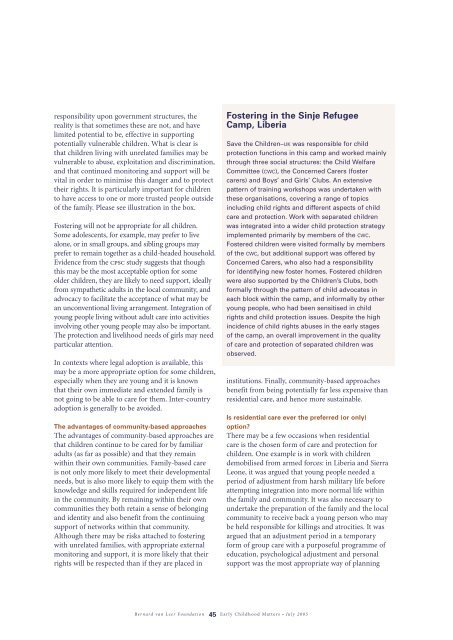Responses to young children in post-emergency situations
Responses to young children in post-emergency situations
Responses to young children in post-emergency situations
Create successful ePaper yourself
Turn your PDF publications into a flip-book with our unique Google optimized e-Paper software.
esponsibility upon government structures, the<br />
reality is that sometimes these are not, and have<br />
limited potential <strong>to</strong> be, effective <strong>in</strong> support<strong>in</strong>g<br />
potentially vulnerable <strong>children</strong>. What is clear is<br />
that <strong>children</strong> liv<strong>in</strong>g with unrelated families may be<br />
vulnerable <strong>to</strong> abuse, exploitation and discrim<strong>in</strong>ation,<br />
and that cont<strong>in</strong>ued moni<strong>to</strong>r<strong>in</strong>g and support will be<br />
vital <strong>in</strong> order <strong>to</strong> m<strong>in</strong>imise this danger and <strong>to</strong> protect<br />
their rights. It is particularly important for <strong>children</strong><br />
<strong>to</strong> have access <strong>to</strong> one or more trusted people outside<br />
of the family. Please see illustration <strong>in</strong> the box.<br />
Foster<strong>in</strong>g will not be appropriate for all <strong>children</strong>.<br />
Some adolescents, for example, may prefer <strong>to</strong> live<br />
alone, or <strong>in</strong> small groups, and sibl<strong>in</strong>g groups may<br />
prefer <strong>to</strong> rema<strong>in</strong> <strong>to</strong>gether as a child-headed household.<br />
Evidence from the cpsc study suggests that though<br />
this may be the most acceptable option for some<br />
older <strong>children</strong>, they are likely <strong>to</strong> need support, ideally<br />
from sympathetic adults <strong>in</strong> the local community, and<br />
advocacy <strong>to</strong> facilitate the acceptance of what may be<br />
an unconventional liv<strong>in</strong>g arrangement. Integration of<br />
<strong>young</strong> people liv<strong>in</strong>g without adult care <strong>in</strong><strong>to</strong> activities<br />
<strong>in</strong>volv<strong>in</strong>g other <strong>young</strong> people may also be important.<br />
The protection and livelihood needs of girls may need<br />
particular attention.<br />
In contexts where legal adoption is available, this<br />
may be a more appropriate option for some <strong>children</strong>,<br />
especially when they are <strong>young</strong> and it is known<br />
that their own immediate and extended family is<br />
not go<strong>in</strong>g <strong>to</strong> be able <strong>to</strong> care for them. Inter-country<br />
adoption is generally <strong>to</strong> be avoided.<br />
The advantages of community-based approaches<br />
The advantages of community-based approaches are<br />
that <strong>children</strong> cont<strong>in</strong>ue <strong>to</strong> be cared for by familiar<br />
adults (as far as possible) and that they rema<strong>in</strong><br />
with<strong>in</strong> their own communities. Family-based care<br />
is not only more likely <strong>to</strong> meet their developmental<br />
needs, but is also more likely <strong>to</strong> equip them with the<br />
knowledge and skills required for <strong>in</strong>dependent life<br />
<strong>in</strong> the community. By rema<strong>in</strong><strong>in</strong>g with<strong>in</strong> their own<br />
communities they both reta<strong>in</strong> a sense of belong<strong>in</strong>g<br />
and identity and also benefit from the cont<strong>in</strong>u<strong>in</strong>g<br />
support of networks with<strong>in</strong> that community.<br />
Although there may be risks attached <strong>to</strong> foster<strong>in</strong>g<br />
with unrelated families, with appropriate external<br />
moni<strong>to</strong>r<strong>in</strong>g and support, it is more likely that their<br />
rights will be respected than if they are placed <strong>in</strong><br />
Foster<strong>in</strong>g <strong>in</strong> the S<strong>in</strong>je Refugee<br />
Camp, Liberia<br />
Save the Children–UK was responsible for child<br />
protection functions <strong>in</strong> this camp and worked ma<strong>in</strong>ly<br />
through three social structures: the Child Welfare<br />
Committee (CWC), the Concerned Carers (foster<br />
carers) and Boys’ and Girls’ Clubs. An extensive<br />
pattern of tra<strong>in</strong><strong>in</strong>g workshops was undertaken with<br />
these organisations, cover<strong>in</strong>g a range of <strong>to</strong>pics<br />
<strong>in</strong>clud<strong>in</strong>g child rights and different aspects of child<br />
care and protection. Work with separated <strong>children</strong><br />
was <strong>in</strong>tegrated <strong>in</strong><strong>to</strong> a wider child protection strategy<br />
implemented primarily by members of the CWC.<br />
Fostered <strong>children</strong> were visited formally by members<br />
of the CWC, but additional support was offered by<br />
Concerned Carers, who also had a responsibility<br />
for identify<strong>in</strong>g new foster homes. Fostered <strong>children</strong><br />
were also supported by the Children’s Clubs, both<br />
formally through the pattern of child advocates <strong>in</strong><br />
each block with<strong>in</strong> the camp, and <strong>in</strong>formally by other<br />
<strong>young</strong> people, who had been sensitised <strong>in</strong> child<br />
rights and child protection issues. Despite the high<br />
<strong>in</strong>cidence of child rights abuses <strong>in</strong> the early stages<br />
of the camp, an overall improvement <strong>in</strong> the quality<br />
of care and protection of separated <strong>children</strong> was<br />
observed.<br />
<strong>in</strong>stitutions. F<strong>in</strong>ally, community-based approaches<br />
benefit from be<strong>in</strong>g potentially far less expensive than<br />
residential care, and hence more susta<strong>in</strong>able.<br />
Is residential care ever the preferred (or only)<br />
option?<br />
There may be a few occasions when residential<br />
care is the chosen form of care and protection for<br />
<strong>children</strong>. One example is <strong>in</strong> work with <strong>children</strong><br />
demobilised from armed forces: <strong>in</strong> Liberia and Sierra<br />
Leone, it was argued that <strong>young</strong> people needed a<br />
period of adjustment from harsh military life before<br />
attempt<strong>in</strong>g <strong>in</strong>tegration <strong>in</strong><strong>to</strong> more normal life with<strong>in</strong><br />
the family and community. It was also necessary <strong>to</strong><br />
undertake the preparation of the family and the local<br />
community <strong>to</strong> receive back a <strong>young</strong> person who may<br />
be held responsible for kill<strong>in</strong>gs and atrocities. It was<br />
argued that an adjustment period <strong>in</strong> a temporary<br />
form of group care with a purposeful programme of<br />
education, psychological adjustment and personal<br />
support was the most appropriate way of plann<strong>in</strong>g<br />
B e r n a r d v a n L e e r Fo u n d a t i o n 45 E a r l y C h i l d h o o d M a t t e r s • Ju l y 2 0 0 5
















